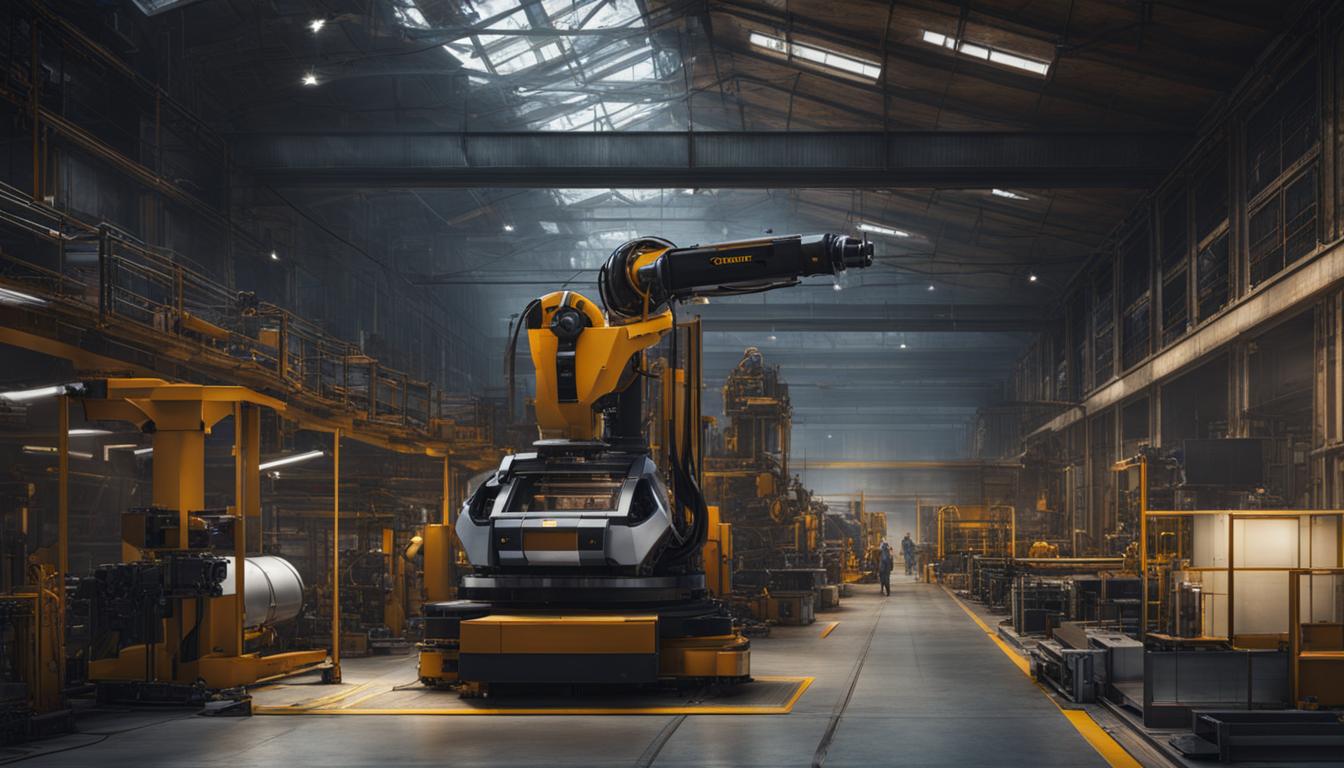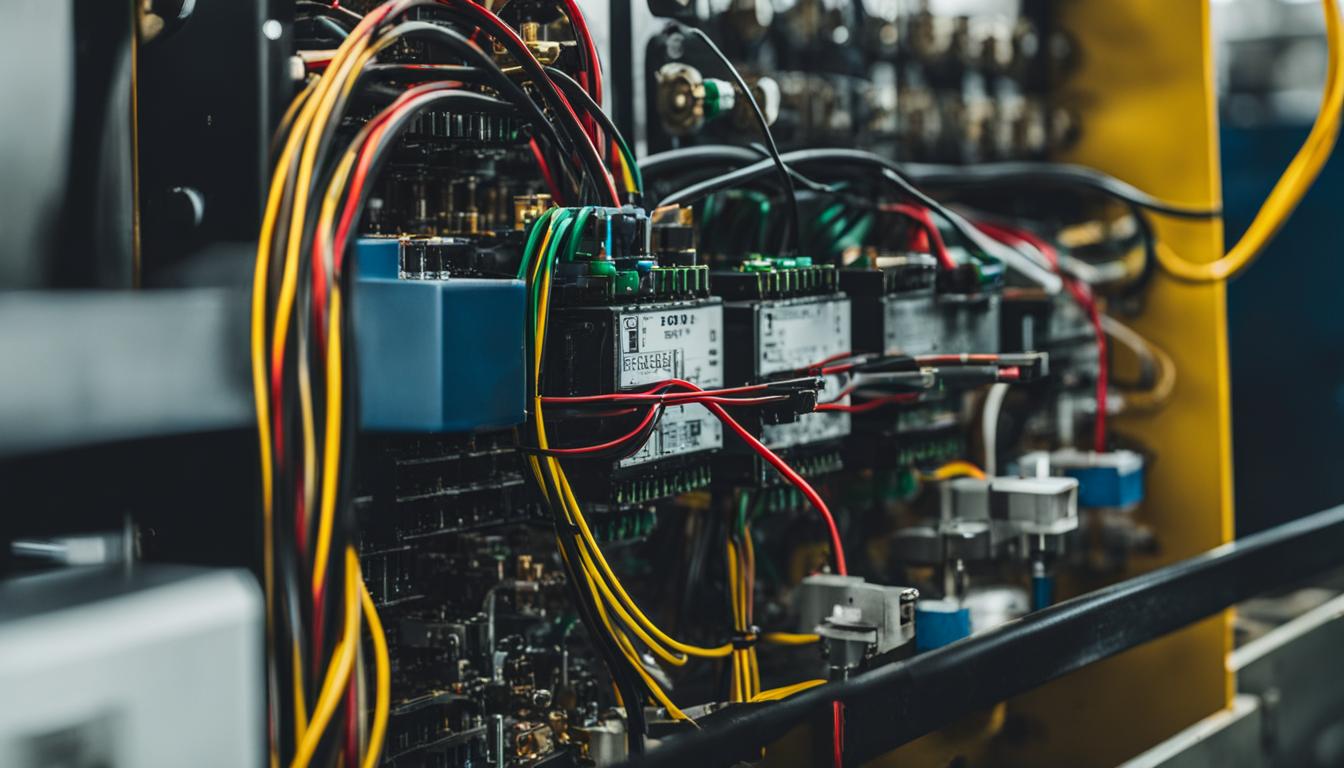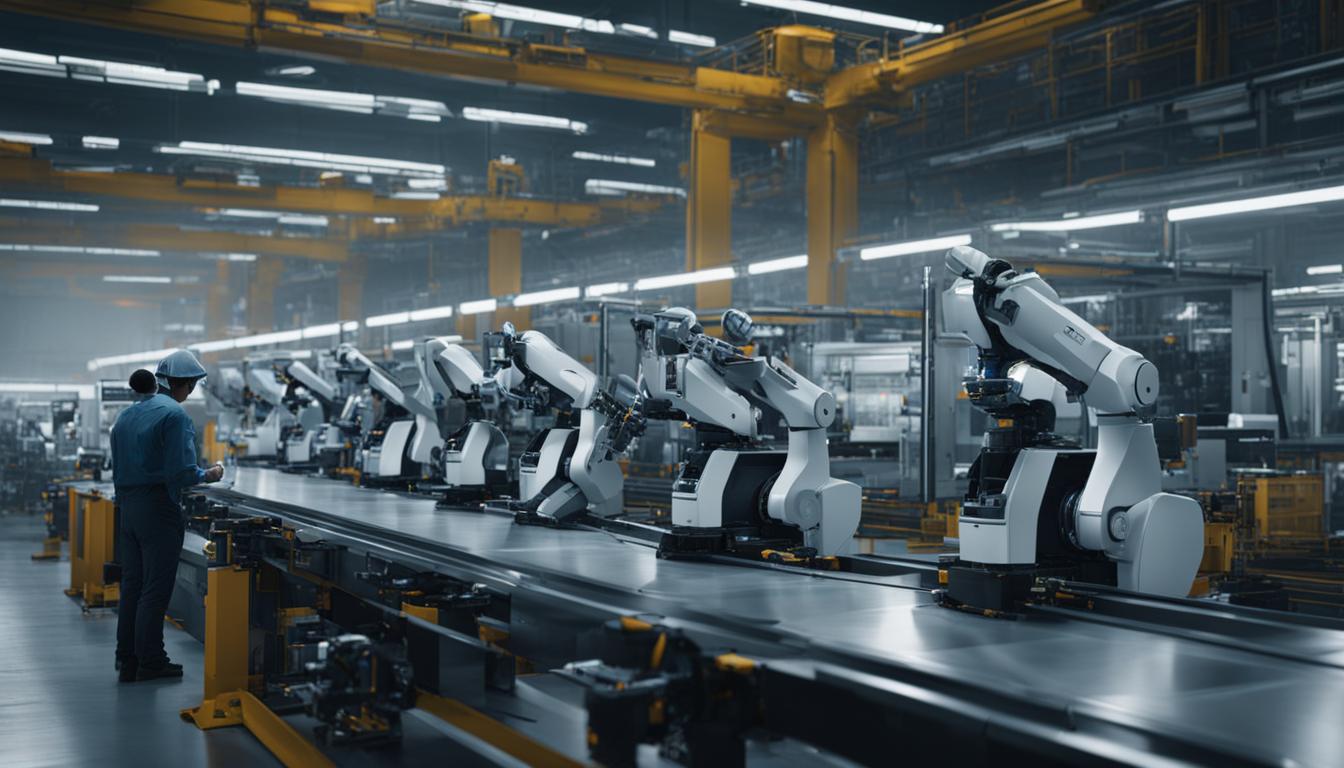Welcome to our comprehensive guide on anodizing in the aerospace industry. In this article, we will explore the importance, benefits, and techniques of anodizing aluminum in aerospace applications. As you may know, aluminum and its alloys are widely used in the aerospace industry due to their exceptional properties. However, to ensure their longevity and performance in demanding environments, anodizing plays a crucial role.
Key Takeaways:
- Anodizing enhances the corrosion resistance and durability of aluminum components in the aerospace industry.
- The process creates a protective oxide layer on the surface of aluminum, providing a barrier against corrosion and wear.
- Anodized aluminum offers improved abrasion resistance and the ability to apply colorful and decorative finishes.
- Germany is known for its high-quality and environmentally-friendly anodizing processes in the aerospace industry.
- Advancements in anodizing technology, such as plasma electrolytic oxidation, contribute to the development of high-performing aerospace components.
The Benefits of Anodizing Aluminium in Aerospace Applications
Anodizing aluminum in aerospace applications offers several benefits that contribute to the overall durability and efficiency of aerospace components. The process of anodizing creates a protective oxide layer on the surface of aluminum, providing enhanced corrosion resistance and improved durability.
Anodized aluminum components are better equipped to withstand the harsh conditions of aerospace environments, with the oxide layer acting as a barrier against moisture, salt, and other corrosive elements. This ensures the longevity of aerospace products, reducing the need for frequent repairs or replacements.
In addition to corrosion resistance, anodizing also enhances the abrasion resistance of aluminum. Aerospace components often face wear and tear due to frequent use and exposure to challenging conditions. Anodizing helps to increase the durability of aluminum, making it more resistant to the impact of abrasion, extending the lifespan of aerospace products.
Furthermore, the anodizing process allows for the application of colorful and decorative finishes to aluminum surfaces. This provides aerospace manufacturers with the flexibility to create visually appealing products that align with their desired aesthetic qualities. These colorful finishes not only enhance the overall look of aerospace products but also contribute to brand identity and customer satisfaction.
Overall, anodizing aluminum in aerospace applications offers benefits such as enhanced corrosion resistance, improved abrasion resistance, and the ability to apply colorful and decorative finishes. These advantages make anodizing a valuable process in the aerospace industry, ensuring the durability and efficiency of aluminum components.
The Anodizing Process for Aluminium in Aerospace
In the aerospace industry, the anodizing process is an essential step in enhancing the durability and performance of aluminum components. It involves creating a protective oxide layer on the surface of the metal, which provides increased corrosion resistance and improves the longevity of aerospace products.
The anodizing process begins with thorough cleaning of the aluminum surface to remove any impurities. Once cleaned, the aluminum is immersed in an electrolyte solution and acts as the anode in an electrochemical cell. An electric current is applied, causing oxidation at the surface of the aluminum and the formation of the oxide layer.
To control the thickness of the oxide layer, the voltage and time of the anodizing process can be adjusted. This allows for precise customization based on the specific requirements of the aerospace industry. After anodization, the aluminum is rinsed and sealed, further enhancing the durability and corrosion resistance of the oxide layer.
This anodizing process offers numerous advantages, including improved corrosion resistance, increased abrasion resistance, and the ability to apply colorful and decorative finishes to aluminum components. By undergoing this surface treatment, aerospace products are better equipped to withstand the harsh conditions they encounter during operation.
| Anodizing Process Steps | Description |
|---|---|
| Cleaning | Thoroughly clean the aluminum surface to remove impurities |
| Anodizing | Immerse the aluminum in an electrolyte solution and apply an electric current to induce oxidation and oxide layer formation |
| Control Thickness | Adjust voltage and time to control the thickness of the oxide layer |
| Rinsing and Sealing | Rinse the anodized aluminum and seal the surface to enhance durability and corrosion resistance |
The anodizing process is a vital aspect of aluminum surface treatment in the aerospace industry. It ensures that aerospace components can withstand demanding operational conditions while maintaining their integrity and performance.

Anodized Aluminum Products in the Aerospace Industry
Anodized aluminum products play a crucial role in the aerospace industry, offering enhanced durability, corrosion resistance, and aesthetic appeal. These products are extensively used in structural components, fasteners, and electronics in various aerospace applications.
Anodizing aluminum provides superior corrosion resistance for structural components, making them suitable for challenging environmental conditions. Fasteners made from anodized aluminum have improved resistance to corrosion and are easier to install and remove.
Anodized aluminum is also used in aerospace electronics and avionics to provide electrical insulation and efficient heat dissipation. This ensures the reliable performance of critical electronic components in demanding aerospace environments.
Anodizing Processes in Germany and Beyond
Germany is at the forefront of anodizing processes for aluminum in the aerospace industry, renowned for its commitment to high-quality and environmentally-friendly practices. German anodizing facilities employ state-of-the-art equipment and techniques to achieve uniform and even oxide layers on aluminum surfaces.
| Advantages of German Anodizing Processes | Key Features |
|---|---|
| 1. Consistency | German anodizing facilities ensure consistent quality and performance by adhering to strict regulations and industry standards. |
| 2. Reliability | German anodizing processes produce reliable and durable anodized aluminum components that meet the stringent requirements of the aerospace industry. |
| 3. Sustainability | These facilities prioritize sustainability and eco-friendly practices, contributing to a more environmentally-conscious aerospace sector. |
Germany’s expertise in anodizing processes has positioned its companies as highly sought-after partners for anodizing aluminum in the global aerospace market.
German anodizing facilities have gained a reputation for their commitment to sustainability, utilizing environmentally-friendly practices that minimize the impact on the environment. By integrating eco-friendly processes into their operations, Germany contributes to reducing the carbon footprint and promoting a greener aerospace industry.
Innovative Techniques and Robust Quality Control
German anodizing facilities employ innovative techniques and rigorous quality control measures to ensure the production of high-quality anodized aluminum components. These facilities prioritize precision, uniformity, and attention to detail, resulting in optimal performance and longevity of the anodized aluminum products.

German anodizing facilities also benefit from their close proximity to leading aerospace manufacturers and research institutions. This proximity enables collaboration, knowledge sharing, and access to cutting-edge advancements in anodizing processes.
Overall, Germany’s leadership in anodizing processes in the aerospace industry stems from its unwavering commitment to excellence, environmental stewardship, and continuous innovation.
Advancements in Anodizing Technology for Aluminium
The field of anodizing technology for aluminum has seen significant advancements, especially in its applications within the aerospace industry. These advancements have revolutionized the way aluminum components are treated and have paved the way for improved durability and performance.
One of the notable advancements in anodizing technology is the use of Plasma Electrolytic Oxidation (PEO). This advanced technique involves subjecting the aluminum surface to a plasma-electrolyte system, resulting in the formation of a ceramic-like oxide layer. The PEO process enhances the corrosion resistance and hardness of the oxide layer, making it ideal for aerospace applications where durability is crucial.
Another area of advancement is surface morphology optimization. This technique focuses on optimizing the surface structure of anodized aluminum components to enhance the adhesion of subsequent coatings and finishes. By improving the surface morphology, the durability of anodized aluminum is significantly enhanced, ensuring it can withstand the demanding conditions of the aerospace industry.
These advancements in anodizing technology have had a significant impact on the aerospace industry. By improving the corrosion resistance, hardness, and durability of aluminum components, anodizing technology has contributed to the development of lightweight and high-performing aerospace components. This not only enhances the overall efficiency of aircraft but also ensures the safety and reliability of aerospace applications.
| Advancements | Benefits |
|---|---|
| Plasma Electrolytic Oxidation (PEO) | Superior corrosion resistance and hardness |
| Surface morphology optimization | Enhanced adhesion of coatings and finishes, improved durability |
As technology continues to advance, we can expect further improvements in anodizing technology for aluminum in aerospace applications. These advancements will provide even greater performance and durability, ensuring that aluminum components remain at the forefront of aerospace innovation.
Process Equipment, Rectifiers, and Chillers in Anodizing
In order to successfully carry out the anodizing process, specialized equipment is required. These components are essential for ensuring efficiency, precision, and optimal results. Let’s take a closer look at the key equipment used in the anodizing process:
Anodize Tanks
Anodize tanks are specifically designed to hold the electrolyte solution used in the anodizing process. These tanks are made from corrosion-resistant materials to withstand the chemical properties of the solution. They come in various sizes to accommodate different objects being anodized.
CNC Machines
CNC (Computer Numerical Control) machines are used for precise and automated control of the anodizing process. These machines ensure consistent and accurate results by controlling the movement and positioning of the objects being anodized. CNC machines are especially beneficial for complex or intricate components.
Rectifiers
Rectifiers play a critical role in controlling the current applied to the electrolytic solution. By precisely adjusting the current, rectifiers help achieve the desired thickness of the anodic oxide layer on the surface of the aluminum. This ensures uniformity and consistency throughout the anodizing process.
Chillers
Chillers are used to maintain optimal temperatures during the anodizing process. Temperature control is essential for the deposition of the metallic oxide layer. Chillers help regulate and stabilize the temperature of the electrolyte solution, enabling uniform and controlled anodizing.
Other Equipment
In addition to the above, various other tanks and equipment are utilized in different process steps during anodizing. These include rinsing tanks, cleaning tanks, and sealing tanks. Each tank serves a specific purpose in the anodizing process, ensuring thorough cleaning, thorough rinsing, and effective sealing of the anodized aluminum components.
The effective use of the anodizing process equipment, including anodize tanks, CNC machines, rectifiers, and chillers, contributes to the overall success and quality of the anodizing process. These equipment pieces work together to provide precise control, optimal temperature regulation, and consistent results, ensuring the durability and corrosion resistance of anodized aluminum components.
Conclusion
Anodizing is an essential process in the aerospace industry that significantly enhances the durability and efficiency of aluminum components. By creating a protective oxide layer on the surface of aluminum, anodizing provides corrosion resistance and extends the lifespan of aerospace products.
One of the key advantages of anodized aluminum products in the aerospace industry is their enhanced corrosion resistance. The oxide layer formed through the anodizing process acts as a barrier against moisture, salt, and other corrosive elements, making aerospace components more resilient in challenging environments.
Moreover, anodized aluminum offers improved abrasion resistance, making it highly suitable for aerospace applications that involve high levels of wear and tear. Additionally, the ability to apply colorful and decorative finishes on anodized aluminum further enhances the aesthetic appeal of aerospace products.
Germany stands out as a leader in anodizing processes, ensuring high-quality and environmentally-friendly practices. German companies excel in achieving even and uniform oxide layers on aluminum surfaces, adhering to strict regulations and industry standards that guarantee the reliability and performance of anodized aluminum components.
Advancements in anodizing technology, such as plasma electrolytic oxidation and surface morphology optimization, contribute to the development of high-performing aerospace components. These innovations provide superior corrosion resistance, hardness, and adhesion properties, enabling the production of lightweight and efficient aerospace products.
Successful anodizing in the aerospace industry requires specialized equipment, including anodize tanks, rectifiers, and chillers for temperature control. These tools allow for precise and optimized anodizing processes, ensuring the desired thickness and quality of the oxide layer on aluminum components.
FAQ
What is the role of anodizing in the aerospace industry?
Anodizing is a crucial process in the aerospace industry for enhancing the corrosion resistance and durability of aluminum components. It involves creating a protective oxide layer on the surface of the aluminum, providing a barrier against corrosion and wear.
What are the benefits of anodizing aluminum in aerospace applications?
Anodized aluminum in aerospace applications offers several benefits, including enhanced corrosion resistance, improved abrasion resistance, and the ability to apply colorful and decorative finishes. It ensures the longevity of aerospace components by providing a barrier against moisture, salt, and other corrosive elements.
How does the anodizing process for aluminum in aerospace work?
The anodizing process involves cleaning the aluminum surface thoroughly and immersing it in an electrolyte solution. The aluminum acts as the anode in an electrochemical cell, and a direct current is applied, causing oxidation and the formation of the protective oxide layer. The thickness of the oxide layer can be controlled by adjusting the voltage and time of the process.
What are anodized aluminum products used for in the aerospace industry?
Anodized aluminum products play a crucial role in the aerospace industry, being used in structural components, fasteners, and electronics. They offer enhanced durability, corrosion resistance, and aesthetic appeal. Anodized aluminum structural components have superior corrosion resistance, while anodized fasteners are easier to install and remove. Anodized aluminum electronics provide electrical insulation and efficient heat dissipation.
What is the significance of anodizing processes in Germany?
Germany is a leader in anodizing processes for aluminum in the aerospace industry, known for its high-quality and environmentally-friendly practices. German anodizing facilities utilize advanced equipment and techniques to achieve even and uniform oxide layers on aluminum surfaces. They adhere to strict regulations and industry standards, ensuring the reliability and performance of anodized aluminum components.
What advancements have been made in anodizing technology for aluminum in aerospace?
The field of anodizing technology for aluminum has witnessed significant advancements, specifically for aerospace applications. Plasma electrolytic oxidation (PEO) is an advanced anodizing technique that produces a ceramic-like oxide layer with superior corrosion resistance and hardness. Surface morphology optimization techniques have been developed to improve the adhesion of subsequent coatings and finishes on anodized aluminum surfaces, enhancing their durability.
What equipment is used in the anodizing process?
The anodizing process requires specialized equipment, including anodize tanks, rectifiers, and chillers. Anodize tanks are used to immerse the aluminum and electrolyte solution, while rectifiers control the current applied to the solution. Chillers are used to maintain optimal temperatures during the process. These equipment ensure control and optimization of the anodizing process.
What is the conclusion regarding anodizing in the aerospace industry?
Anodizing plays a crucial role in the aerospace industry by enhancing the durability and efficiency of aluminum components. It creates a protective oxide layer that provides corrosion resistance and improves the longevity of aerospace products. Anodized aluminum products offer enhanced corrosion resistance, improved abrasion resistance, and the ability to apply colorful and decorative finishes. Advancements in anodizing technology contribute to the development of high-performing aerospace components.




